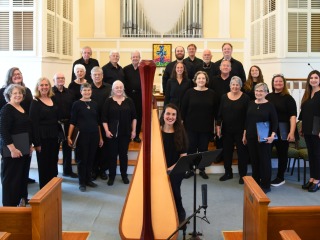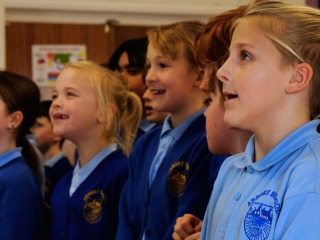MENU
01 Oct 2012
Here is not meant the putative witch herself but rather the dating of the rhyme itself. While “Jinny the Witch” is nowadays synonymous with Hop-tu-Naa itself, as a rhyme it is only a part of what once was a much wider song tradition in the Island connected with this Hollantide calendar custom and one which has seen change over the past century or so. It is clear that there was once a very different and, moreover, lengthier song text from the nineteenth century, the one recorded by collectors of the time and versions of which appeared in A.W. Moore’s Manx Ballads and Music (1896) and Dr John Clague’s Cooinaghtyn Manninagh: Manx Reminiscences (1911). Moore’s text consists of some twenty-two lines; Clague’s version is slightly longer with twenty-six lines recorded. Sung with a refrain after each line this must have been a lengthy piece to perform and of course thereby reduced the amount of money that one could collect from a household for its performance.
This version (referred to here for convenience as “the nineteenth century text”) appears to have been generally known across the Island and recounts the events of a supposed feast taking place on the (presumably) evening of the 30 October. The action is surrealistic: firstly, a heifer is chosen with which to make broth. Upon tasting it, the broth maker’s throat is scalded and they run to a well to drink water in order to soothe it. Returning, they meet either a witch-cat (or a polecat) and make a hasty flight to Scotland. There, they meet a woman “baking bannocks and roasting collaps,” or cutting cheese.
At the same date that the nineteenth century text was collected, the forerunner of “Jinny the Witch” was also recorded. The first thing that must be noted is the name: “Jenny Swinny,” Dr John Clague [1892 or after]; “Jinny Squinney,” Rev. T.E. Brown (1895); “Jinny the Winny,” Edmund Goodwin (1912); “Jinnie the Winnie,” vamd (1924); “Jinny the Whinney,” W.W. Gill (1932); “Jinny the Winny,” J.J. Kneen (1935); “Jinny Squinny,” Cyril I. Paton (1941); “Ginny the Swinney,” Charles E. Watterson [c. 1948–50]; “Jinny the Spinney,” John Comish (1950–55). Not a witch in sight. Until the recent programme of digitising the Manx newspapers, the earliest reference to “Jinny the Witch” was by one C. Ethel Flanagan from an interview by the Manx Museum Folk-Life Survey in 1957. Newspaper accounts (six in number) giving “Jinny the Witch” (and the rhyme largely in the form that we know it today) date largely between 1944 and 1960—and earlier from 1900, published by “Oie-Hauiney” in the Manx Sun for 3 November: “Jinny the Witch went over the house / To get a stick to lather the mouse / Jinny the Witch went up to the claddagh / To get her apron full of faggots.”
What at first seemed like a neat separation (as well as a linear development) between the names of the character has been thrown into doubt by this 1900 text; that said, it is a singular appearance in both the printed and oral record of the rhyme for its date. It is difficult to see how this name (“Jinny the Witch”) was not recorded by any of the figures mentioned above, most of who were in fact active collectors of Manx folklore. That said, even if the 1900 text is an anomalous one, the question still stands as to when and how the earlier recorded names dropped out to be replaced by “Jinny the Witch” and for the rhyme to develop its present form.
Returning to the nineteenth century text, changed and localised versions of that song appear in Castletown and Peel. The action is maintained but “Jinnie the Winnie” now appears, later to be changed to “Jinny the Witch” in the case of the Peel version. The textual addition is simply that, an insertion that does not add to the narrative and so is an episode that stands apart. The lengthier version (from Peel) comes from W.W. Gill’s version published in 1932: “I saw Jinny the Whinney / Go over the lake / A griddle in her hand / All ready to bake / Her teeth were green / And her eyes were red / And a thickness of hair at her / Upon her head.” From Castletown, as noted down by Charles Watterson (c. 1948–50): “Ginny-theswinney went over the house / To get a rod to baet [beat] the mouse / Ginney-the-swinney went through the hole / To get a rod to baet the foal.” The Castletown episode has the familiar form of the rhyme sung today and would seem to be able to be sung separately unlike the Peel one; but, as ever, without a wide textual base to all of the songs and rhymes much comment remains speculative.
The Castletown version does not appear now to be known at all whereas the Peel text is still in circulation. That there is a differing text sung on the west coast of the Island is often a complete surprise to those on the east coast who know just the “Jinny the Witch” rhyme. (And for that matter the turnip lantern is held differently, the stalk being used as a handle.) Why does this version continue while the Castletown one has gone? Peel School when opened in 1953, so the Isle of Man Examiner reported in 1967, had held since that date an annual “Hop-tu-Naa Competition,” and that year alone 150 children had entered the competition. The Peel text, published in the Vocabulary of the Anglo-Manx Dialect in 1924, has the cachet not only of obviously being from the town itself and a different and distinctive text from those of the rest of the Island, but also associated with the names of Sophia Morrison and Edmund Goodwin, Peel-born and editors of the Vocabulary. Such an activity as reported here has the result of promoting and maintaining the Peel text for children born and brought up in the town. The Examiner piece reported that “[t]his tradition of ‘hop-tu-naa’ has been carried on in the school since it was first built in 1953 […],” and further, it is “a 14-year-old Tradition of Peel School.” One might wonder how it can be called a tradition after just fourteen years but it does show how a community handles the notion of tradition albeit here in the form of an institutional setting and promotion rather than as an academic notion.
Hop-tu-Naa is a Manx calendar custom that has come under pressure from two directions. Firstly, from the Church of England, with the accusation of its association with Satanism through the simple name of the subject of the rhyme, “Jinny the Witch” and the common perception that it is a Celtic custom and thereby Pre-Christian and Pagan. The Bishop of Sodor and Mann in 1992 called on his fl ock (and others) in the title of an article in the Diocesan News to “Celebrate Hallowe’en as a Christian Festival,” suggesting a “Saints and Sausages” or “Banners and Buns” evening instead of Hop-tu-Naa. Secondly, from the increasing influence of the American-inspired commercialisation of Hallowe’en; as Colin Jerry had written the previous year in Yn Pabyr Seyr, it is “Hop-tu-Naa not Hallowe’en” (the title of his article there).
The earliest link between Hop-tu-Naa and the notion that it has an association with witchcraft comes from 1934, when the Examiner reported on St Mathew’s holding a Hallowe’en party for the children of the school. As part of the decoration in the school hall there was what was described as a “witches’ kitchen.” A photograph of the event held the next year, 1935, shows that the witch was no other than the Vicar himself dressed up as an old crone—presumably “Jinny the Witch,” though that, frustratingly, is not stated. He (or rather, when in character, she) is described as “brooding over the pot.”
We are still left to “brood” over “Jinny the Witch” and, for that matter, the “pot” that is Hop-tu-Naa in general. The custom has seen considerable change: the familiar lantern carved from a moot is a recent innovation as indeed is the “Jinny the Witch” rhyme. This has displaced the nineteenth century text all over the Island save for Peel. But even there, that version was maintained through the intervention of Peel School. The incorporation of a notion of witchcraft into Hop-tu-Naa was through the advent of the “witches’ kitchen” in the 1930s at St Mathews. It is somewhat ironic that a custom that was later to be castigated by the Bishop of Sodor and Mann as having satanic roots had its likely origin in the dressing up by one of his former vicars as a witch in more recent times.
Stephen Miller, Vienna

Paid performance opportunity: ‘Cree’ Manx language and song project
30 Jun 2025
Read More...
This Fair Isle: Manx music arranged by Kevin Kelly
04 Jun 2025
Read More...
School celebrated in new Manx film
04 Jun 2025
Read More...
Contact, Links, Acknowledgements, Privacy
© Culture Vannin. Culture Vannin is the trading name for the Manx Heritage Foundation, registered charity 333 in the Isle of Man. Designed by 3 Legs Ltd.